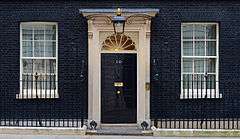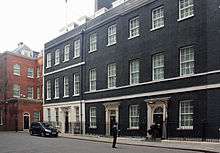First Lord of the Treasury
The First Lord of the Treasury is the head of the commission exercising the ancient office of Lord High Treasurer in the United Kingdom, and is now always also the Prime Minister. This office is not equivalent to the usual position of the "Treasurer" in other governments; the closer equivalent of a Treasurer in the United Kingdom is the Chancellor of the Exchequer, who is the Second Lord of the Treasury.
Lords of the Treasury
As of the beginning of the 17th century, the running of the Treasury was frequently entrusted to a commission, rather than to a single individual. As of 1714, it has permanently been in commission. The commissioners have always since that date been referred to as Lords Commissioners of the Treasury, and adopted ordinal numbers to describe their seniority. Eventually in the middle of the same century, the First Lord of the Treasury came to be seen as the natural head of the overall ministry running the country, and, as of the time of Robert Walpole (Whig), began to be known, unofficially, as the Prime Minister. The term Prime Minister was initially, but decreasingly, used as a term of derogation: it was first used officially in a royal warrant only in 1905. William Pitt the Younger once opined that the Prime Minister "ought to be the person at the head of the finances."[1]
Prior to 1827 the First Lord of the Treasury also held the office of Chancellor of the Exchequer unless he was a peer and thus barred from that office; in this case, the Second Lord of the Treasury usually served as Chancellor. As of 1827, the Chancellor of the Exchequer has always been Second Lord of the Treasury when he was not also Prime Minister. By convention, the other Lords Commissioners of the Treasury are also Government Whips in the House of Commons.
Official residence

10 Downing Street is the official residence of the First Lord of the Treasury, and not of the Prime Minister. The only official prime ministerial residence is Chequers, a country house in Buckinghamshire used as a weekend and holiday home. As all modern prime ministers have simultaneously been First Lord of the Treasury and Prime Minister, 10 Downing Street has come to be identified closely with the prime minister.
List of First Lords of the Treasury, 1714–1905
Much of this list overlaps with the list of Prime Ministers of the United Kingdom, but there are some notable differences, principally concerning the Marquess of Salisbury, who was Prime Minister but not First Lord in 1885–86, 1887–92 and 1895–1902. Those First Lords who were simultaneously Prime Minister are indicated by the use of bold typeface; those First Lords who were considered Prime Minister only during part of their term are indicated by the use of bold italic typeface.
| Name | Entered office | Left office | Political party | |
|---|---|---|---|---|
| The Earl of Halifax | 13 October 1714 | 19 May 1715 | Whig | |
| The Earl of Carlisle | 23 May 1715 | 10 October 1715 | Whig | |
| Robert Walpole | 10 October 1715 | 12 April 1717 | Whig | |
| The Earl Stanhope | 12 April 1717 | 21 March 1718 | Whig | |
| The Earl of Sunderland | 21 March 1718 | 4 April 1721 | Whig | |
| Sir Robert Walpole | 4 April 1721 | 11 February 1742 | Whig | |
| The Earl of Wilmington | 16 February 1742 | 2 July 1743 | Whig | |
| Henry Pelham | 27 August 1743 | 6 March 1754 | Whig | |
| The Duke of Newcastle | 16 March 1754 | 16 November 1756 | Whig | |
| The Duke of Devonshire | 16 November 1756 | 8 June 1757 | Whig | |
| James Waldegrave, 2nd Earl Waldegrave | 8 June 1757 | 12 June 1757 | Whig | |
| The Duke of Devonshire | 12 June 1757 | 25 June 1757 | Whig | |
| The Duke of Newcastle | 2 July 1757 | 26 May 1762 | Whig | |
| The Earl of Bute | 26 May 1762 | 16 April 1763 | Tory | |
| George Grenville | 16 April 1763 | 13 July 1765 | Whig | |
| The Marquess of Rockingham | 13 July 1765 | 30 July 1766 | Whig | |
| The Duke of Grafton[2] | 30 July 1766 | 28 January 1770 | Whig | |
| Lord North | 28 January 1770 | 22 March 1782 | Tory | |
| The Marquess of Rockingham | 27 March 1782 | 1 July 1782 | Whig | |
| The Earl of Shelburne | 4 July 1782 | 2 April 1783 | Whig | |
| The Duke of Portland | 2 April 1783 | 19 December 1783 | Whig | |
| William Pitt the Younger | 19 December 1783 | 14 March 1801 | Tory | |
| Henry Addington | 17 March 1801 | 10 May 1804 | Tory | |
| William Pitt the Younger | 10 May 1804 | 23 January 1806 | Tory | |
| The Lord Grenville | 11 February 1806 | 31 March 1807 | Whig | |
| The Duke of Portland | 31 March 1807 | 4 October 1809 | Whig | |
| Spencer Perceval | 4 October 1809 | 11 May 1812 | Tory | |
| The Earl of Liverpool | 9 June 1812 | 10 April 1827 | Tory | |
| George Canning | 10 April 1827 | 8 August 1827 | Tory | |
| The Viscount Goderich | 31 August 1827 | 22 January 1828 | Tory | |
| The Duke of Wellington | 22 January 1828 | 22 November 1830 | Tory | |
| The Earl Grey | 22 November 1830 | 16 July 1834 | Whig | |
| The Viscount Melbourne | 16 July 1834 | 14 November 1834 | Whig | |
| The Duke of Wellington | 14 November 1834 | 10 December 1834 | Tory | |
| Sir Robert Peel | 10 December 1834 | 8 April 1835 | Tory | |
| The Viscount Melbourne | 18 April 1835 | 30 August 1841 | Whig | |
| Sir Robert Peel | 30 August 1841 | 29 June 1846 | Conservative | |
| Lord John Russell | 30 June 1846 | 23 February 1852 | Whig | |
| The Earl of Derby | 23 February 1852 | 19 December 1852 | Conservative | |
| The Earl of Aberdeen | 19 December 1852 | 6 February 1855 | Peelite | |
| The Viscount Palmerston | 6 February 1855 | 20 February 1858 | Liberal | |
| The Earl of Derby | 20 February 1858 | 12 June 1859 | Conservative | |
| The Viscount Palmerston | 12 June 1859 | 18 October 1865 | Liberal | |
| The Earl Russell | 29 October 1865 | 28 June 1866 | Liberal | |
| The Earl of Derby | 28 June 1866 | 27 February 1868 | Conservative | |
| Benjamin Disraeli | 27 February 1868 | 3 December 1868 | Conservative | |
| William Ewart Gladstone | 3 December 1868 | 20 February 1874 | Liberal | |
| Benjamin Disraeli (from 1876 as The Earl of Beaconsfield) |
20 February 1874 | 23 April 1880 | Conservative | |
| William Ewart Gladstone | 23 April 1880 | 23 June 1885 | Liberal | |
| The Earl of Iddesleigh | 29 June 1885 | 1 February 1886 | Conservative | |
| William Ewart Gladstone | 1 February 1886 | 25 July 1886 | Liberal | |
| The Marquess of Salisbury[3] | 3 August 1886 | 14 January 1887 | Conservative | |
| William Henry Smith | 14 January 1887 | 6 October 1891 | Conservative | |
| Arthur Balfour | 6 October 1891 | 15 August 1892 | Conservative | |
| William Ewart Gladstone | 15 August 1892 | 5 March 1894 | Liberal | |
| The Earl of Rosebery | 5 March 1894 | 25 June 1895 | Liberal | |
| Arthur Balfour[4] | 25 June 1895 | 5 December 1905 | Conservative | |
Thereafter the posts of First Lord of the Treasury and Prime Minister have continually been held by the same person; see the list of 20th century British prime ministers.
See also
Notes
- ↑ Andrew Blick and George Jones (June 2010). "The power of the Prime Minister". History & Policy. United Kingdom: History & Policy. Retrieved 9 December 2010.
- ↑ Grafton was also Prime Minister from 14 October 1768
- ↑ Salisbury was also Prime Minister until 11 August 1892
- ↑ Balfour was also Prime Minister from 11 July 1902 onwards
References
- E.B. Fryde, D.E. Greenway, S. Porter, and I. Roy, ed. Handbook of British Chronology, 3rd Edition
- Haydn, Joseph Timothy. The Book of Dignities (1894)
External links
- HM Government, First Lord of the Treasury
.svg.png)
.jpg)

